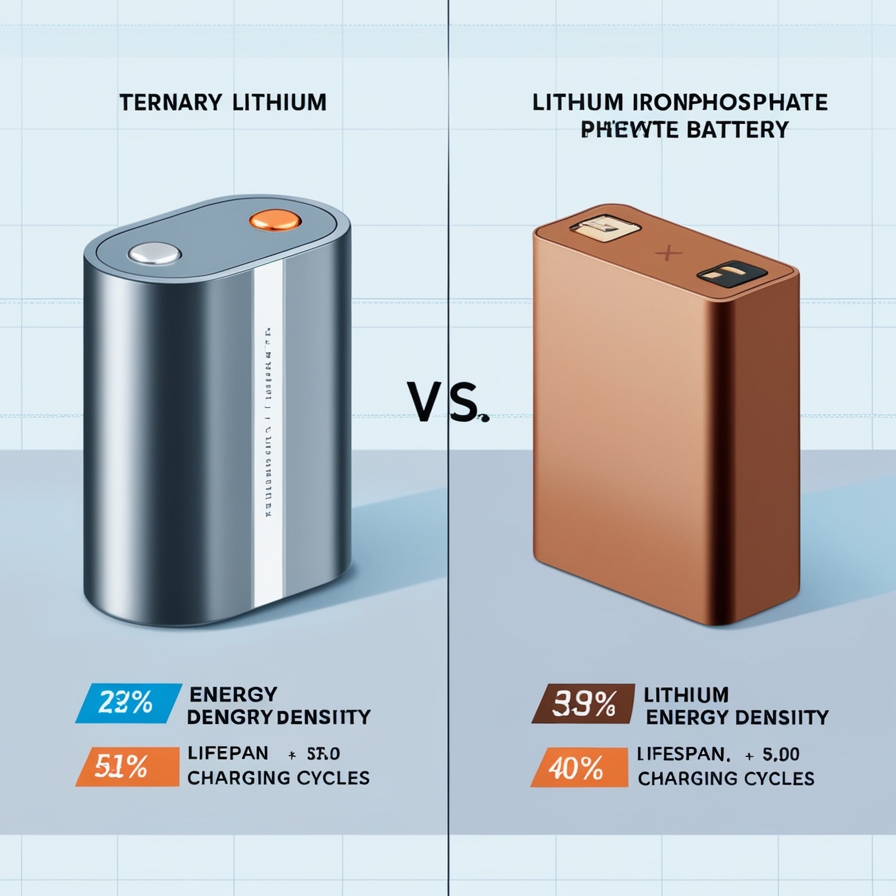Introduction:
Ternary lithium batteries and lithium iron phosphate batteries are the two main types of lithium batteries currently widely used in electric vehicles, energy storage systems and other electronic devices. But have you understood their characteristics and differences? Their chemical composition, performance characteristics and application fields are significantly different. Let’s learn more about them with Heltec.

Material composition:
Ternary lithium battery: The positive electrode material is usually nickel cobalt manganese oxide (NCM) or nickel cobalt aluminum oxide (NCA), which is composed of nickel, cobalt, manganese or nickel, cobalt, aluminum and other metal elements oxides, and the negative electrode is generally graphite. Among them, the ratio of nickel, cobalt, manganese (or aluminum) can be adjusted according to actual needs.
Lithium iron phosphate battery: lithium iron phosphate (LiFePO₄) is used as the positive electrode material, and graphite is also used for the negative electrode. Its chemical composition is relatively stable, and it does not contain heavy metals and rare metals, which is more environmentally friendly.
Charge and discharge performance:
Ternary lithium battery: fast charge and discharge speed, can adapt to high current charge and discharge, suitable for equipment and scenarios with high requirements for charging speed, such as electric vehicles that support fast charging. In low temperature environment, its charge and discharge performance is also relatively good, and the capacity loss is relatively small.
Lithium iron phosphate battery: relatively slow charge and discharge speed, but stable cycle charge and discharge performance. It can support high rate charging and can be fully charged in 1 hour at the fastest, but the charge and discharge efficiency is usually around 80%, which is slightly lower than that of ternary lithium battery. Under low temperature conditions, its performance declines significantly, and the battery capacity retention rate may be only 50%-60%.
Energy density:
Ternary lithium battery: The energy density is relatively high, usually reaching more than 200Wh/kg, and some advanced products can exceed 260Wh/kg. This allows ternary lithium batteries to store more energy at the same volume or weight, providing longer driving range for devices, such as in electric vehicles, which can support vehicles to travel longer distances.
Lithium iron phosphate battery: The energy density is relatively low, generally around 110-150Wh/kg. Therefore, in order to achieve the same driving range as ternary lithium batteries, lithium iron phosphate batteries may require a larger volume or weight
Cycle life:
Ternary lithium battery: The cycle life is relatively short, with a theoretical cycle number of about 2,000 times. In actual use, the capacity may have decayed to about 60% after 1,000 cycles. Improper use, such as overcharging or discharging, and use in high temperature environments, will accelerate the battery decay.
Lithium iron phosphate battery: Long cycle life, with more than 3,500 charge and discharge cycles, and some high-quality batteries can even reach more than 5,000 times, which is equivalent to more than 10 years of use. It has good lattice stability, and the insertion and removal of lithium ions have little effect on the lattice, and has good reversibility
Safety:
Ternary lithium battery: poor thermal stability, easy to cause thermal runaway under high temperature, overcharge, short circuit and other conditions, resulting in a relatively high risk of combustion or even explosion. However, with the advancement of technology and the strengthening of safety measures, such as the use of more advanced battery management systems and optimization of battery structure, its safety is also constantly improving.
Lithium iron phosphate battery: good thermal stability, the positive electrode material is not easy to release oxygen at high temperature, and will not begin to decompose until 700-800℃, and will not release oxygen molecules when facing impact, puncture, short circuit and other situations, and is not prone to violent combustion, with high safety performance.
Cost:
Ternary lithium battery: because the positive electrode material contains expensive metal elements such as nickel and cobalt, and the production process requirements are high, and the environmental requirements are also stricter, so the cost is relatively high.
Lithium iron phosphate battery: the price of raw materials is relatively low, the production process is relatively simple, and the overall cost has certain advantages. For example, in new energy vehicles, models equipped with lithium iron phosphate batteries are often relatively low in price.
Conclusion
The choice of battery depends mainly on the specific application requirements. If higher energy density and longer battery life are required, ternary lithium batteries may be a better choice; if safety, durability and long life are the priorities, lithium iron phosphate batteries are more suitable.
Heltec Energy is your trusted partner in battery pack manufacturing. With our relentless focus on research and development, coupled with our comprehensive range of battery accessories, we offer one-stop solutions to meet the evolving needs of the industry. Our commitment to excellence, tailored solutions, and strong customer partnerships make us the go-to choice for battery pack manufacturers and suppliers worldwide.
If you have any questions or would like to learn more, please don't hesitate to reach out to us.
Request for Quotation:
Jacqueline: jacqueline@heltec-energy.com / +86 185 8375 6538
Sucre: sucre@heltec-bms.com / +86 136 8844 2313
Nancy: nancy@heltec-energy.com / +86 184 8223 7713
Post time: Dec-27-2024

